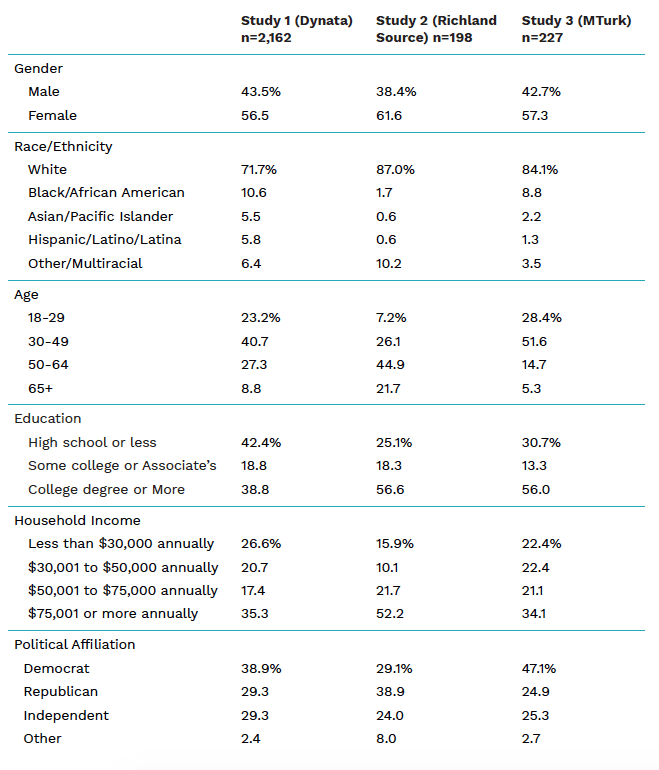Solutions journalism offers comprehensive coverage of an issue by proposing solutions rather than just focusing on the problem. The Center for Media Engagement set out to determine how certain components of solutions journalism affect the way readers evaluate both the reporting and the issue. We found that stories covering several core components of solutions journalism:
- Improved readers’ perception of article quality.
- Increased readers’ intentions to engage.
- Increased readers’ interest in and knowledge about the issue.
- Boosted readers’ positivity.
The Problem
Solutions journalism strives to include what is sometimes overlooked: reporting not just about the problems facing society, but about how communities respond to them. The Center for Media Engagement previously found that readers of solutions journalism feel more informed, optimistic, and interested in engaging with an issue. But solutions journalism is about more than stating a possible solution to a problem. This study, supported by the Bill and Melinda Gates Foundation with contributions from The Impact Architects, breaks down solutions journalism into five core components:
- Problem : The causes and symptoms of the issue,
- Solution : The replicable ideas tied to solving the problem,
- Implementation : The how-to details of putting the solution into action,
- Results : The progress, data-based or anecdotal, that has been made in working toward a solution, and
- Insights : The teachable, big-picture lessons that can be learned beyond one particular solution or situation.
This project sought to understand the value of reporting on these components and to determine whether certain components are more powerful in affecting readers’ attitudes.
Key Findings
Articles that included all five components of solutions journalism:
- Improved readers’ perception of article quality.
- Made readers more likely to “like” a similar article on Facebook.
- Increased readers’ interest in and knowledge about the issue.
- Increased intentions to read more articles about the issue.
- Boosted readers’ positivity.
- Led readers to believe there were ways to effectively address the issue.
Implications for Newsrooms
When it comes to solutions journalism, the more information you can provide readers, the better. Adding additional components beyond the problem and the solution (i.e. implementation, results, and insights) can bolster positive responses to your work. Readers who are given all five components feel more positive about the issue, rate the article as higher quality, and are more likely to “like” a similar article on Facebook. Reading articles with all five components also inspired heightened interest in the issue and more of a willingness to read future articles about the issue. This could be especially useful for news organizations trying to attract loyal readers to a reporting series.
However, parts of this project also suggest that the addition of components beyond the problem and solution is only influential when news organizations provide comprehensive reporting on these first two components. Without this foundation, the effect of the other three components is weakened. It is important that journalists take the time to fully explain the issue and the response before exploring implementation, results, and insights.
The Study
Participants read an article that contained a discussion of:
- The problem.
- The problem and solutions.
- The problem, solutions, and the solutions’ implementation.
- The problem, solutions, the solutions’ implementation, and results.
- The problem, solutions, the solutions’ implementation, results, and insights for future work.
We then asked readers to respond to a series of statements about the quality of the article, their feelings about the issue, and their intentions to take action related to the issue.
We found that reading an article with all five components:
Improved readers’ perception of article quality
Readers rated the articles that included all five components as the highest quality among all of the articles.1
Readers were more likely to say the article seemed different from a typical news article if they read an article that contained at least one more component of solutions journalism beyond the problem and solution.2
Perceived Quality of the Article
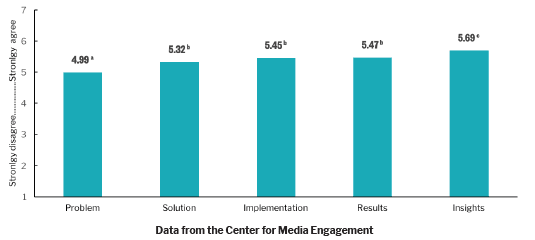
Increased readers’ intentions to engage
Readers of articles with all five components were more likely to say that they would “like” a similar article on Facebook than those who just read about a problem.3
Participants expressed more willingness to read additional articles about the issue when they read a version with all five components than those who just read about a problem.4
Likelihood of Reading More Articles About the Issue
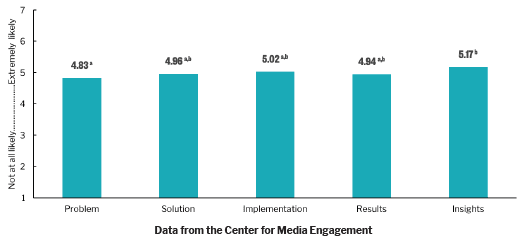
Increased readers’ interest in and knowledge about the issue
Participants who read an article with all five components were more likely to say the article increased their interest in the issue than those who just read about a problem and solution.5
Participants felt more knowledgeable about the issue if they read an article that included results and insights.6
Participants who read an article with all five components were more likely to believe there were ways to address the problem effectively than those who just read about a problem and solution.7
I Feel Better Informed About the Issue Discussed in the Article
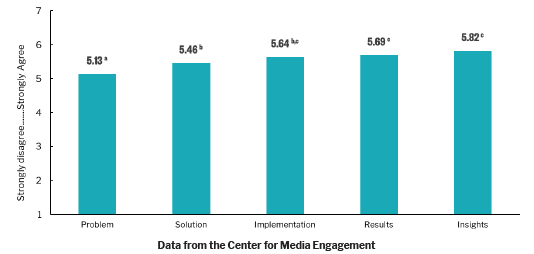
Boosted readers’ positivity
Participants who read an article that included at least one more component beyond the problem and solution were significantly more likely to express positive emotions after reading the article.8
Intensity of Positive Emotions
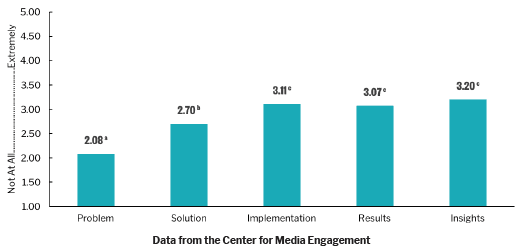
The articles differed in length,9 but when we controlled for the amount of time participants spent reading the article, the majority of the results remained unaffected and for the variables where we did see some change, the differences were minor.10
Extending the Findings
To test if these findings apply to an existing publication, as opposed to the mock publication we used in the previous study, we conducted an additional experiment with Richland Source, a local online news source in North Central Ohio that practices solutions journalism.
We created two versions of a Richland Source article about food insecurity: one that explained only the problem and the solution and one that explored all five components of solutions journalism. The two articles were approximately the same length.11 Participants read one of the two articles and answered the same series of questions as participants from the first study.
Out of all the measures we tested, only one showed a significant difference between groups. Participants who read the article with only the problem and solution were more likely to say that they believed they could contribute to a solution, compared to those who read the article with all five components.12 This finding differs from the first study, in which no significant difference was found between these groups.
It was not clear why we got this result. One possible explanation was that, in cutting the articles to be approximately the same length, we inadvertently left out critical details in the article containing all five components that remained present in the article focused only on the problem and solution.
To evaluate this possibility, we conducted a follow-up survey among 227 people living in Ohio using Amazon’s Mechanical Turk Platform. In this study, we added a third condition, where people were asked to read an article which combined all of the information from the two other food insecurity articles into a longer piece.13 We discovered one significant finding: people who read the longer article with all five components were significantly more likely to say that the article increased their interest in the issue than those who only read about a problem and solution.14 This suggests that there is a benefit to including all five components of solutions journalism in an article, but only when it also includes comprehensive reporting about the solution and the problem.
Methodology
We studied five basic components of solutions journalism for this project:
- Problem : The causes and symptoms of the issue,
- Solution : The replicable ideas tied to solving the problem,
- Implementation : The how-to details of putting the solution into action,
- Results : The progress, data-based or anecdotal, that has been made in working toward a solution, and
- Insights : The teachable, big-picture lessons that can be learned beyond one particular solution or situation.
This project consisted of three separate experiments. In the first experiment, we tested the following combinations of the solutions journalism components:
- The problem.
- The problem and solutions.
- The problem, solutions, and the solutions’ implementation.
- The problem, solutions, the solutions’ implementation, and results.
- The problem, solutions, the solutions’ implementation, results, and insights for future work.
Using two previously published news articles, one about an education program from NPR and one about criminal justice from The Guardian, researchers created five versions of each article matching the combinations above. Participants were randomly assigned to view one of the articles. After reading the article, they were asked questions about their emotions, their attitudes toward the article, and their intentions to engage with the issue the article addressed. They were also asked demographic questions. We worked with Dynata (Research Now/SSI) to gather 2,162 participants.
Additional results are included in the tables below:
Participant Emotions

Intentions to Engage with the Issue
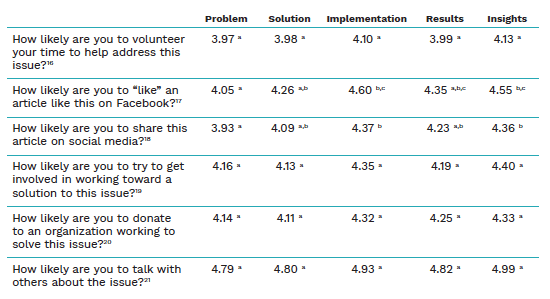
Attitude Toward the Article

The second experiment was conducted with 198 Richland Source readers. Richland Source distributed the survey to its readers by posting on social media, linking to the survey in a newsletter, and posting a link to the survey on their website. Participants were randomly assigned to read one of two articles: one that outlined only the problem and solution and one that contained all five elements of solutions journalism. These participants answered the same questions about their attitudes and demographics as participants in the first study.
The only significant finding from the Richland Source study is shown in the table below:

The third study was conducted with 227 people from Ohio using Amazon’s Mechanical Turk platform. The survey was identical to the original Richland Source study, but with one addition: some participants read an expanded article that combined the two articles from the original study. The only significant finding from the third study is shown in the table below:

All experiments in this project were embedded in a survey using Qualtrics’ survey platform.
Participant Demographics
SUGGESTED CITATION:
Murray, Caroline and Stroud, Natalie Jomini. (2019, August). The keys to powerful solutions journalism. Center for Media Engagement. https://mediaengagement.org/research/powerful-solutions-journalism
- On a scale of 1 (strongly disagree) to 7 (strongly agree), readers were asked how well a series of positive adjectives (Full list: enjoyable, trustworthy, interesting, informative, clear, credible, well-written) applied to the news article. We combined the positive adjectives into a single variable to test for differences (Cronbach’s alpha: 0.877). We tested the differences among the conditions using ANOVA. There was a significant effect of condition F(4, 2156) = 32.03, p < .05. There was not a significant interaction between topic and condition. As Levene’s Test was significant, we used Games-Howell post-hoc tests. [↩]
- We asked participants to rate their agreement with the statement “The article seemed different from a typical news article” on a 1 (strongly disagree) to 7 (strongly agree) scale. We tested the differences among the conditions using ANOVA. There was a significant effect of condition F(4, 2154) = 10.06, p < .05. There was not a significant interaction between topic and condition. As Levene’s Test was significant, we used Games-Howell post-hoc tests. [↩]
- We asked participants how likely they were to “like” an article on Facebook on a scale of 1 (extremely unlikely) to 7 (extremely likely). We tested the differences between conditions using ANOVA, which showed no significant interaction between topic and condition. There was a significant effect of condition F(4, 2147) = 5.60, p < .05. [↩]
- We asked participants how likely they were to read more articles about the issue on a scale of 1 (extremely unlikely) to 7 (extremely likely). We tested the differences between conditions using ANOVA, which showed no significant interaction between topic and condition. There was a significant effect of condition F(4, 2149) = 2.77, p < .05. [↩]
- We asked participants to rate their agreement with the statement “The article increased my interest in the issue” on a 1 (strongly disagree) to 7 (strongly agree) scale. We tested the differences between conditions using ANOVA, which showed no significant interaction between topic and condition. There was a significant effect of condition F(4, 2142) = 6.94, p < .05. [↩]
- We asked participants to rate their agreement with the statement “I feel better informed about the issue” on a 1 (strongly disagree) to 7 (strongly agree) scale. We tested the differences among the conditions using ANOVA. There was not a significant interaction between topic and condition. As Levene’s Test was significant, we used Games-Howell post-hoc tests. There was a significant effect of condition F(4, 2149) = 21.77, p < .05. [↩]
- We asked participants to rate their agreement with the statement “I think there are ways to effectively address this problem” on a 1 (strongly disagree) to 7 (strongly agree) scale. We tested the difference using ANOVA. There was not a significant interaction between topic and condition. As Levene’s Test was significant, we used Games-Howell post-hoc tests. There was a significant effect of condition F(4, 2157) = 7.82, p < .05. [↩]
- We asked participants to rate how intensely they were feeling certain adjectives (Full list: upset, inspired, nervous, determined, afraid, optimistic, depressed, frustrated, motivated) on a scale of 1 (not at all) to 5 (extremely). We combined the positive adjectives into a single variable (Cronbach’s alpha: 0.877). We then tested the differences among the conditions using ANOVA. There was not a significant interaction between topic and condition. There was a significant effect of condition F(4, 2151) = 91.99, p < .05. [↩]
- The problem-only articles were 290 (education) and 325 (criminal justice) words long. The articles that added a solution were 449 (education) and 486 (criminal justice) words long. The articles that added the implementation component were 728 (education) and 701 (criminal justice) words long. The articles that added results were 1,035 (education) and 805 (criminal justice) words long. The articles that had all five elements of solutions journalism were 1,079 (education) and 1,009 (criminal justice) words long. [↩]
- We tested the differences using ANOVA. In the cases where we saw unequal variances, we used a regression analysis to test the differences. We saw changes to five variables. Participants in Condition 2 were significantly more likely to agree with the following statements than those in Condition 1: “The article influenced my opinion about the issue” and “I think there are ways to effectively address the problem.” Participants in Conditions 3 and 5 also responded significantly differently when asked about whether their opinion was influenced. Participants in Condition 3 felt significantly better informed than those in Condition 2. Participants in Condition 4 no longer responded significantly different than those in Condition 2 to the statement “The article did not increase my knowledge about the issue.” Only those in Condition 5 showed a significant difference in increased interest in the issue from any other condition. [↩]
- The problem and solution article was 541 words long and the article with all five components was 542 words long. [↩]
- We tested the differences between conditions using ANOVA. There was a significant effect of condition F(1,181) = 5.33, p < .05. [↩][↩]
- The article that combined the two other article versions was 793 words long. [↩]
- We tested the differences between conditions using ANOVA. There was a significant effect of condition F(2,223) = 3.48, p < .05. [↩][↩]
- We combined the negative adjectives into a single variable (Cronbach’s alpha: 0.867). A univariate analysis showed a significant interaction between topic and condition. The results displayed are one-way ANOVA analyses spilt by topic. For the education article, there was a significant effect of condition F(4, 1088) = 42.18, p < .05. For the criminal justice article, there was a significant effect of condition F(4, 1063) = 23.76, p < .05. [↩]
- Based on the ANOVA, no significant differences between conditions were found. [↩][↩][↩][↩]
- We tested the differences between conditions using ANOVA, which showed no significant interaction between topic and condition. There was a significant effect of condition F(4, 2147) = 5.60, p < .05. [↩]
- We tested the differences between conditions using ANOVA, which showed no significant interaction between topic and condition. There was a significant effect of condition F(4, 2150) = 3.63, p < .05. [↩]
- We tested the differences among the conditions using ANOVA. There was not a significant interaction between topic and condition. As Levene’s Test was significant, we used Games-Howell post-hoc tests. There was a significant effect of condition F(4, 2154) = 10.06, p < .05. [↩]
- We tested the differences among the conditions using ANOVA. There was not a significant interaction between topic and condition. As Levene’s Test was significant, we used Games-Howell post-hoc tests. There was a significant effect of condition F(4, 2140) = 17.16, p < .05. [↩]
- We tested the differences between conditions using ANOVA, which showed no significant interaction between topic and condition. There was a significant effect of condition F(4, 2142) = 6.94, p < .05 [↩]
- We tested the differences between conditions using ANOVA, which showed no significant interaction between topic and condition. There was a significant effect of condition F(4, 2148) = 6.13, p < .05. There was also a significant effect of article topic F(4, 2148) = 8.10, p < .05. [↩]
- We tested the difference using ANOVA. There was not a significant interaction between topic and condition. As Levene’s Test was significant, we used Games-Howell post-hoc tests. There was a significant effect of condition F(4, 2157) = 7.82, p < .05. [↩]
- We tested the difference using ANOVA. There was not a significant interaction between topic and condition. As Levene’s Test was significant, we used Games-Howell post-hoc tests. There was a significant effect of condition F(4, 2150) = 2.33, p < .05. [↩]




